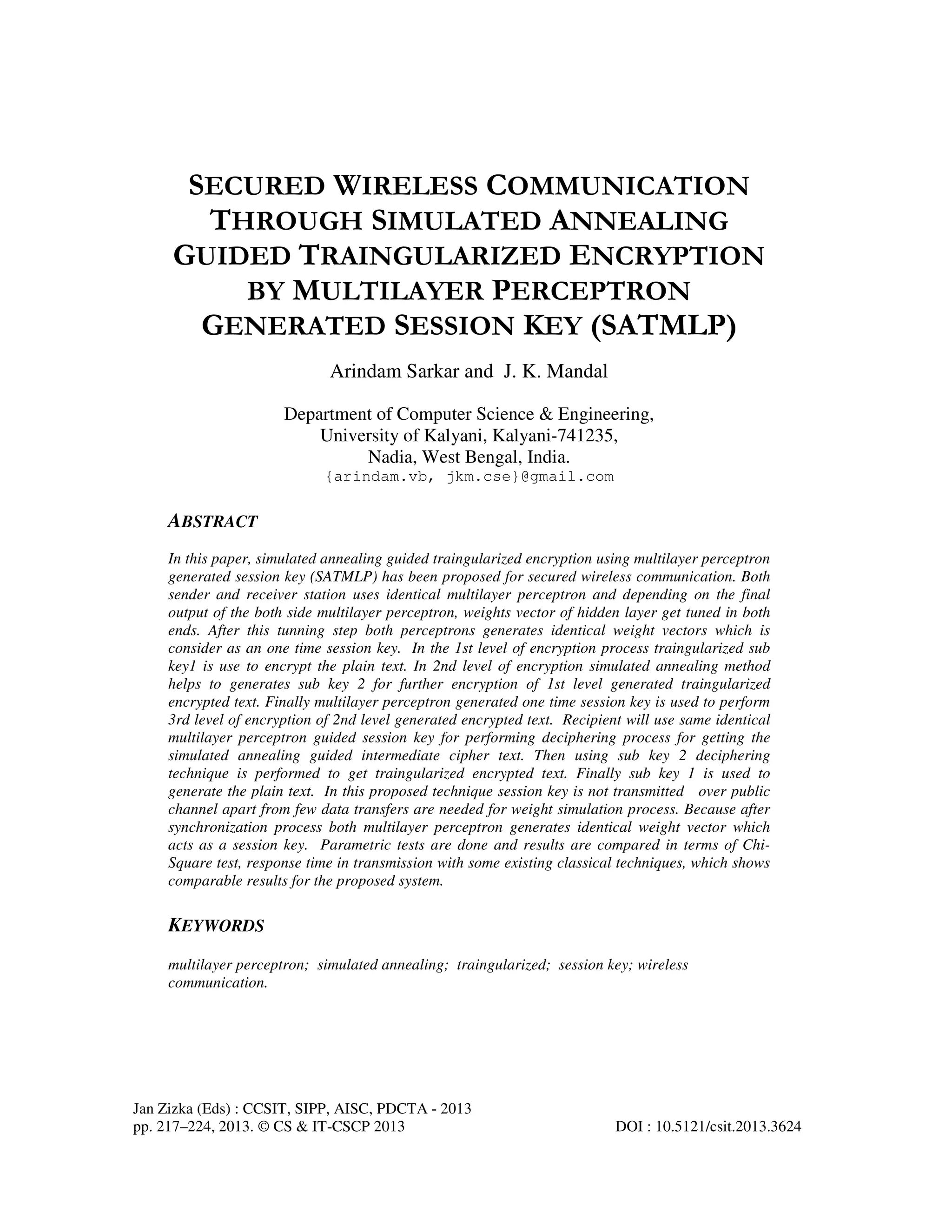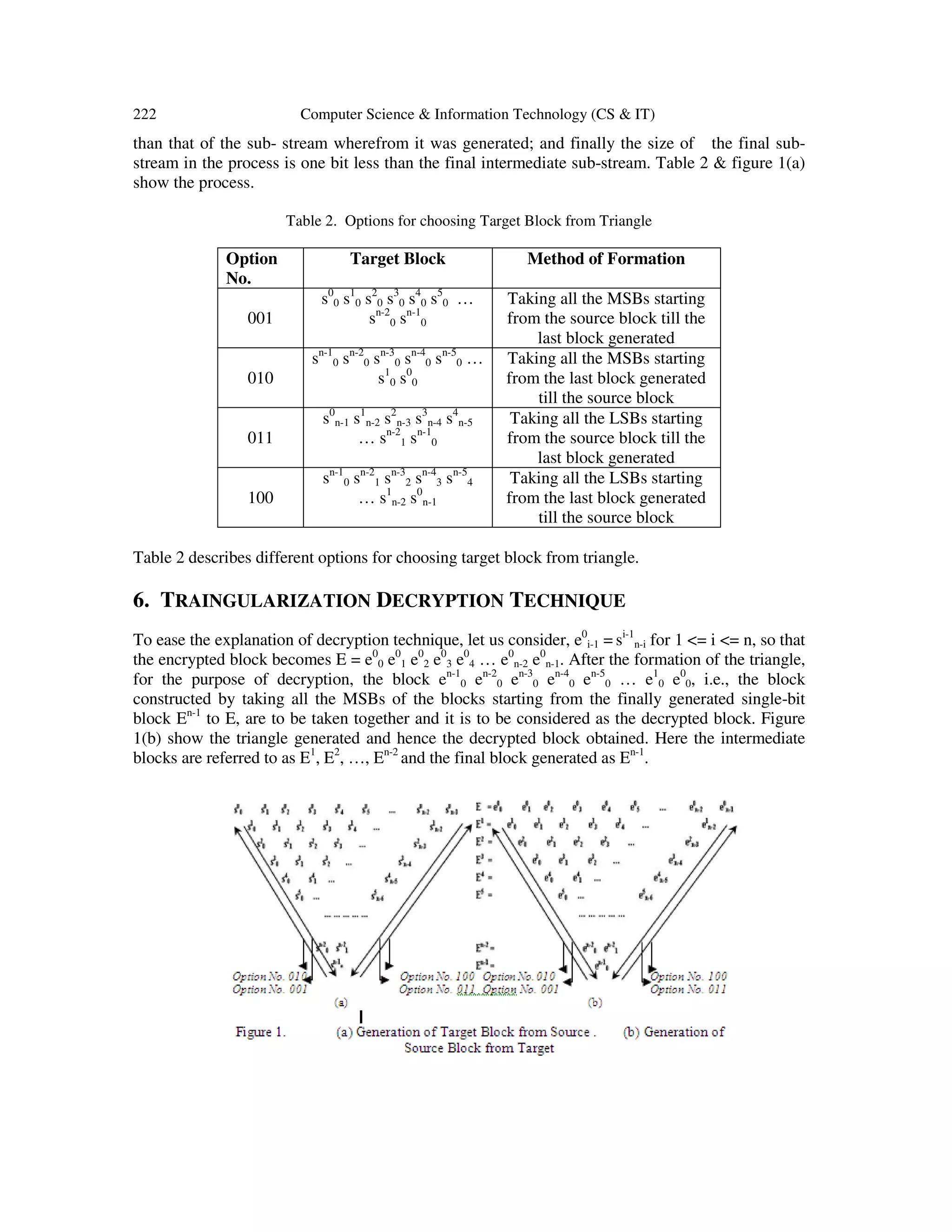The document presents a novel approach to secure wireless communication using simulated annealing guided triangularized encryption with a multilayer perceptron (MLP) generated session key. It describes a method where both sender and receiver synchronize their MLPs to create an identical session key without transmitting it over public channels, thus mitigating man-in-the-middle attacks. The proposed technique is evaluated and compared with existing classical methods, demonstrating comparable performance in terms of security and efficiency.

![218 Computer Science & Information Technology (CS & IT)
1. INTRODUCTION
These days a range of techniques are available to preserve data and information from
eavesdroppers [1]. Each algorithm has its own advantages and disadvantages. Security of the
encrypted text exclusively depends on the key used for encryption. In cryptography the main
security intimidation is man-in-the-middle attack at the time of exchange the secret session key
over public channel.
In this paper, a secret session key generation mechanism has been projected using multilayer
perceptron synchronization scheme i.e. session key generation using activated hidden layer’s
weight vector of sender & receiver’s multilayer perceptron synchronization process.
The sturdiness of the key is calculated in terms of linear complexity, randomness and correlation
immunity. To devise a key following 4 basic features like large period of key, large linear
complexity of the key, good random key sequence, high order of correlation immunity of the key
sequence is required. In this paper, additional sub key generation mechanism has been also
proposed using local random search algorithm i.e. Simulated Annealing (SA) for encryption of
the 1st level traingularized encrypted text. This SA based key generation methods generates key
which satisfies all 4 basic features.
The organization of this paper is as follows. Section 2 of the paper deals with the problem domain
and methodology. Proposed SATMLP i.e. multilayer perceptron synchronization system for
generation of session key has been discussed in section 3. Section 4 deals with proposed SA
based sub key generation. Traingularized encryption and decryption technique described in
section 5 and 6 respectively. Experimental results of proposed technique are given in section 7.
Section 8 provides the security related analysis. Conclusions and future scope are drawn in
section 9 and that of references at end.
2. PROBLEM DOMAIN AND METHODOLOGY
In cryptography, the main problem is to distribution of key between sender and receiver. Because
at the time of exchange of key over public channel intruders can intercept the key by residing in
between them. This particular problem is discussed in following sub section and proposed
technique addressed this problem.
A. Man-In-The-Middle Attack
Intruders may exist between sender & receiver and tries to capture every single information
transmitting from both parties. Diffie-Hellman key swap over technique [1] suffers from this
problem. Intruders can perform as sender and receiver concurrently and try to whip secret session
key at the time of exchanging key via public channel. This renowned problem is being addressed
in SATMLP where secret session key is not exchanged over public insecure channel. At end of
neural weight synchronization strategy of both parties’ generates identical output from the hidden
layer when generates one time secret session key.
B. Methodology in SATMLP
This well known problem of middle man attack has been addressed in SATMLP where secret
session key is not exchanged over public insecure channel. At end of multilayer perceptron](https://image.slidesharecdn.com/csit3624-180201084822/75/SECURED-WIRELESS-COMMUNICATION-THROUGH-SIMULATED-ANNEALING-GUIDED-TRAINGULARIZED-ENCRYPTION-BY-MULTILAYER-PERCEPTRON-GENERATED-SESSION-KEY-SATMLP-2-2048.jpg)
![Computer Science & Information Technology (CS & IT) 219
weight synchronization strategy of both parties’ generates identical weight vectors and activated
hidden layer outputs for both the parties become identical. This identical output of hidden layer
for both parties can be use as one time secret session key for secured data exchange.
3. MULTILAYER PERCEPTRON BASED SESSION KEY GENERATION
A multilayer perceptron synaptic weight based key generation is carried out between receiver and
sender [2, 3, 4, 5, 6, 7, 8]. Sender and receivers multilayer perceptron select same single hidden
layer among multiple hidden layers for a particular session. For that session all other hidden layers
goes in deactivated mode means hidden (processing) units of other layers do nothing with the
incoming input. Synchronized identical weight vector of sender and receivers’ input layer
activated hidden layer and output layer becomes session key. The key generation technique and
analysis of the technique is discussed in the subsections A and B. Sender and receiver multilayer
perceptron in each session acts as a single layer network with dynamically chosen one activated
hidden layer and K no. of hidden neurons, N no. of input neurons having binary input vector,
{ }1,1 +−∈ijx , discrete weights, are generated from input to output, are lies between -L and +L,
{ }LLLwij ++−−∈ ,...,1, .Where i = 1,…,K denotes the ith
hidden unit of the perceptron and j = 1,…,N the
elements of the vector and one output neuron. Output of the hidden units is calculated by the
weighted sum over the current input values. So, the state of the each hidden neurons is expressed
using (eq.1)
ji
N
j
jiiii xw
N
xw
N
h ,
1
,
11
∑=
== (1)
Output of the ith
hidden unit is defined as )sgn( ii h=σ (2)
But in case of ih = 0 then iσ = -1 to produce a binary output. Hence a, iσ = +1, if the weighted
sum over its inputs is positive, or else it is inactive, iσ = -1. The total output of a perceptron is the
product of the hidden units expressed in (eq. 2) ∏=
=
K
i
i
1
στ (3)
Multilayer Perceptron Synchronization Algorithm
Input: - Random weights, input vectors for both multilayer perceptrons.
Output: - Secret key through synchronization of input and output neurons as vectors.
Method:-
Step 1. Initialization of random weight values of synaptic links between input layer and randomly
selected activated hidden layer. Where, { }LLLwij ++−−∈ ,...,1, (4)
Step 2. Repeat step 3 to 6 until the full synchronization is achieved, using Hebbian-learning
rules. ( ) ( )( )BA
ijiji xwgw ji τττστ ΘΘ+=+
,,, (5)
Step 3. Generate random input vector X. Inputs are generated by a third party or one of the
communicating parties.](https://image.slidesharecdn.com/csit3624-180201084822/75/SECURED-WIRELESS-COMMUNICATION-THROUGH-SIMULATED-ANNEALING-GUIDED-TRAINGULARIZED-ENCRYPTION-BY-MULTILAYER-PERCEPTRON-GENERATED-SESSION-KEY-SATMLP-3-2048.jpg)

![Computer Science & Information Technology (CS & IT) 221
1__ C_C_ 10
−
−= ψψFaultDerivativeBinary (9)
Table 1. Binary xor Operation Table
First Bit Second Bit Result
0 0 0
0 1 1
1 0 1
1 1 0
Where, C_ Ψ0: Count no. of 0’s in new bit stream. C_ Ψ1: Count no. of 1’s in new bit stream.
Change Point Test: In this test a check point is created for observing maximum difference
between, the proportions of 1’s including the check point and the proportions of 1’s after the
check point using eq. (10) , eq. ( 11) & eq. ( 12).
D[Cp]= Ψ* K[Cp]- Cp* K[Ψ] (10)
[ ] [ ]( )( )ψψψψρ KKM
r
−−= **/2exp 2
(11)
ρ r
FaultPoChange =int__ (12)
Ψ: Total no. of bit in the stream. K[Ψ]: Total no. of 1’s in the bit stream.
Cp: Change Point. K[Cp]: Total no. of 1’s to bit Cp (Change Point). D[Cp]: Difference respect to
the Change point. M: MAX (ABS ( D[Cp] ) ), for Cp=1.. Ψ.
ρr
: Probability of statistics that smaller value of ρ r
more significant the result.
Finally, fault of every test is summed up for calculating fitness function. Using eq. (13) fitness is
calculated.
Fault
FunctionFitness
+
=
1
1
_ (13)
Cooling Procedure
To determining the cooling schedule in case of optimization problem in annealing process
requires some parameters for initial value of control parameter, decrement function of control
parameter, length of individual distance parameter, stopping criteria.
5. TRAINGULARIZATION ENCRYPTION TECHNIQUE
During plain text encryption, in the first phase consider a block S = s0
0 s0
1 s0
2 s0
3 s0
4 s0
5 … s0
n-2 s0
n-
1 of size n bits, where s0
i = 0 or 1 for 0 <= i <= (n-1). Now, starting from MSB (s0
0) and the next-
to-MSB (s0
1), bits are pair-wise XORed, so that the 1st
intermediate sub-stream S1
= s1
0 s1
1 s1
2 s1
3
s1
4 s1
5 … s1
n-2 is generated consisting of (n-1) bits, where s1
j = s0
j ⊕ s0
j+1 for 0 <= j <= n-2, ⊕
stands for the exclusive OR operation. This 1st
intermediate sub-stream S1
is also then pair-wise
XORed to generate S2
= s2
0 s2
1 s2
2 s2
3 s2
4 s2
5 … s2
n-3, which is the 2nd
intermediate sub-stream of
length (n-2). This process continues (n-1) times to ultimately generate Sn-1
= sn-1
0, which is a
single bit only. Thus the size of the 1st
intermediate sub-stream is one bit less than the source sub-
stream; the size of each of the intermediate sub-streams starting from the 2nd
one is one bit less](https://image.slidesharecdn.com/csit3624-180201084822/75/SECURED-WIRELESS-COMMUNICATION-THROUGH-SIMULATED-ANNEALING-GUIDED-TRAINGULARIZED-ENCRYPTION-BY-MULTILAYER-PERCEPTRON-GENERATED-SESSION-KEY-SATMLP-5-2048.jpg)

![Computer Science & Information Technology (CS & IT) 223
7. EXPERIMENTAL RESULTS
In this segment the results of implementation of the proposed technique has been presented in
terms of Chi-Square test, no. of data exchanged & iterations needed for neural hidden layer
synchronization with different parameter’s value, synchronization snapshot & synchronized
weight. The results are also compared with existing RSA & TDES [1] technique. Table 3 shows
Chi-Square value for different source stream size after applying different encryption algorithms. It
is seen that the Chi-Square value of proposed is better compared to the algorithm TDES and
comparable to the Chi-Square value of the RSA algorithm. Figure 2. shows graphical
representation of stream size vs. Chi square value. Figure 3. Shows simulation graph for formation
of asymmetrical to symmetric synchronized weight matrix for N=10, K=10,L=4. Table 4 shows
total no. of iteration needed & no. of data being transferred for synaptic simulation process with
different input(N) & hidden(H) neurons and varying synaptic depth(L).
8. SECURITY OF THE SATMLP TECHNIQUE
The main difference between the partners and the attacker in neural machine is that sender and
receiver are able to influence each other by communicating their output bits A
τ & B
τ while
attacker can only listen to these messages. Of course, sender and receiver use their advantage to
select suitable input vectors for adjusting the weights. These confirm that the security of neural
cryptography is based on the bidirectional interaction of the partners. Each partener uses a
seperate, but identical pseudo random no. generator. As these devices are initialized with a secret
seed state shared by sender and receiver. They produce exactly the same sequence of input bits.](https://image.slidesharecdn.com/csit3624-180201084822/75/SECURED-WIRELESS-COMMUNICATION-THROUGH-SIMULATED-ANNEALING-GUIDED-TRAINGULARIZED-ENCRYPTION-BY-MULTILAYER-PERCEPTRON-GENERATED-SESSION-KEY-SATMLP-7-2048.jpg)
![224 Computer Science & Information Technology (CS & IT)
Where as attacker does not know this secret seed state. By increasing synaptic depth average
synchronize time will be increased polynomial time. But success probability of attacker will be
drop exponentially
9. FUTURE SCOPE & CONCLUSION
This paper presents a novel approach for generation of secret key proposed algorithm using
neural hidden layer. This technique enhances the security features of the key exchange algorithm
by increasing of the synaptic depth L of the neural machine. In this case, the two partners sender
and receiver do not have to exchange a common secret key over a public channel but use their
indistinguishable weights as a secret key needed for encryption or decryption. So likelihood of
attack proposed technique is much lesser than the simple key exchange algorithm. Future scope
of this technique is that this neural model can be used in wireless communication. Some
evolutionary algorithm can be incorporated with this neural model to get well distributed weight
vector.
ACKNOWLEDGMENT
The author expressed deep sense of gratitude to the Department of Science & Technology (DST) ,
Govt. of India, for financial assistance through INSPIRE Fellowship leading for a PhD work
under which this work has been carried out, at the department of Computer Science &
Engineering, University of Kalyani.
REFERENCES
[1] Atul Kahate, Cryptography and Network Security, 2003, Tata McGraw-Hill publishing Company
Limited, Eighth reprint (2006).
[2] Mandal, J. K., Sarkar Arindam, “An Adaptive Genetic Key Based Neural Encryption For Online
Wireless Communication (AGKNE)”, International Conference on Recent Trends In Information
Systems (RETIS 2011) BY IEEE, 21-23 December 2011, Jadavpur University, Kolkata, India. ISBN
978-1-4577-0791-9, (2011)
[3] R. Mislovaty, Y. Perchenok, I. Kanter, and W. Kinzel. Secure key-exchange protocol with an absence
of injective functions. Phys. Rev. E, 66:066102, (2002).
[4] A. Ruttor, W. Kinzel, R. Naeh, and I. Kanter. Genetic attack on neural cryptography. Phys. Rev. E,
73(3):036121, (2006).
[5] A. Engel and C. Van den Broeck. Statistical Mechanics of Learning. Cambridge University Press,
Cambridge, (2001).
[6] T. Godhavari, N. R. Alainelu and R. Soundararajan “Cryptography Using Neural Network ” IEEE
Indicon 2005 Conference, Chennai, India, 11-13 Dec. (2005).gg
[7] Wolfgang Kinzel and ldo Kanter, "Interacting neural networks and cryptography", Advances in Solid
State Physics, Ed. by B. Kramer (Springer, Berlin. 2002), Vol. 42, p. 383 arXiv- cond-mat/0203011,
(2002)
[8] Wolfgang Kinzel and ldo Kanter, "Neural cryptography" proceedings of the 9th international
conference on Neural Information processing(ICONIP 02), (2002).](https://image.slidesharecdn.com/csit3624-180201084822/75/SECURED-WIRELESS-COMMUNICATION-THROUGH-SIMULATED-ANNEALING-GUIDED-TRAINGULARIZED-ENCRYPTION-BY-MULTILAYER-PERCEPTRON-GENERATED-SESSION-KEY-SATMLP-8-2048.jpg)